Muscle memory makes the body move without needing to think about it. You reach for a glass, take a step, or tie your shoes, and your body just does it. That’s muscle memory in action. But after an amputation, that smooth connection between brain and body breaks. Moving with a prosthetic doesn’t feel natural at first. Everything must be relearned, from small movements to full-body balance.
The good news? With practice, the brain and body can form new patterns. And when those patterns are built the right way, they become automatic again. That’s how prosthetic users start walking without looking down, using a hand to grip without overthinking, or balancing without wobbles.
But here’s the catch—building muscle memory takes time, effort, and repetition. And repetition can feel boring, especially when progress is slow.
That’s where gamified rehab changes the game.
At Robobionics, we’ve seen how turning therapy into something more playful and interactive helps prosthetic users stay focused, consistent, and confident. Gamification doesn’t just make rehab more fun—it helps create lasting muscle memory, faster and more naturally. Let’s explore how and why it works.
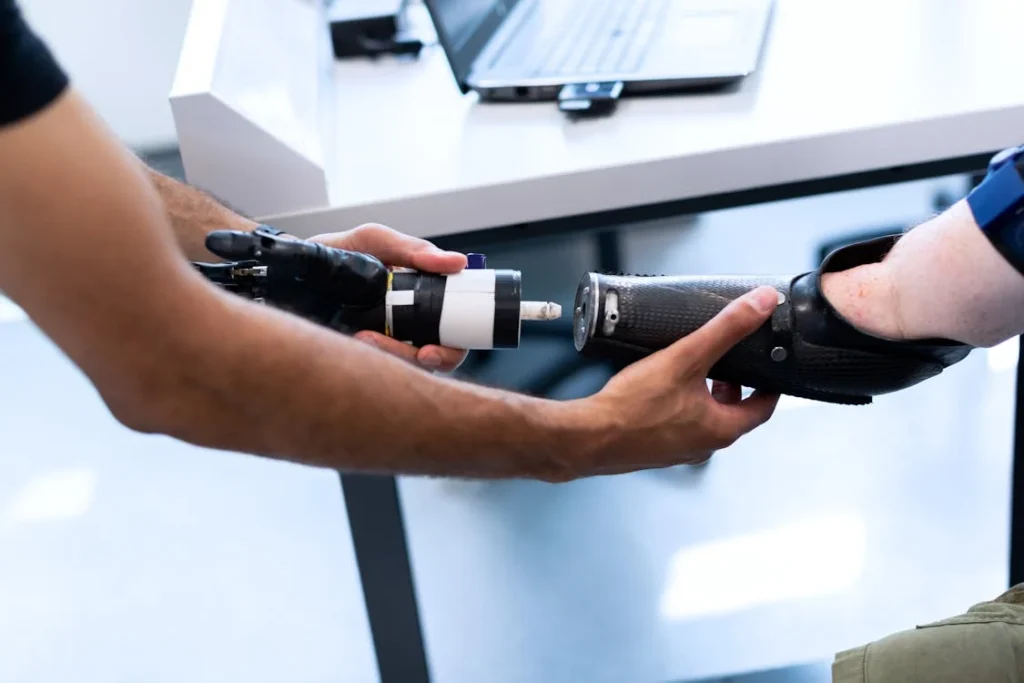
Gamified Rehab: More Than Just Play
Why Repetition Matters—and Why It’s So Hard
To build muscle memory with a prosthetic, the body needs to repeat movements over and over. These aren’t random movements—they’re specific, task-based, and tied to real-life actions like grasping, stepping, or stabilizing weight.
This repetition builds neural pathways. The more the brain fires those pathways, the stronger they become. Eventually, they run in the background. That’s muscle memory.
But here’s the problem: repeating the same motion daily—especially when it feels awkward or difficult—is not easy. People get bored. They get frustrated. And when the brain loses interest, it also stops learning as effectively. That’s not a lack of willpower. It’s how attention works.
Gamified rehab solves this by making repetition feel fresh.
Instead of asking someone to pick up a block twenty times, we ask them to play a game where picking up the block earns points. Instead of practicing balance for five minutes straight, we turn it into a level they need to complete. Suddenly, the same motion becomes part of something bigger. The brain stays alert. The body keeps practicing. And the learning sticks.
That’s the first key: gamification extends attention. And longer attention means deeper memory.
Feedback That Feeds the Brain
When you move your natural limb, your body gives you constant feedback. You feel pressure, position, and motion. But prosthetic limbs often have reduced or no sensory input. That makes it hard to tell if you’re doing something right. And if you don’t get that feedback, you can’t adjust your movement or improve your technique.
Gamified rehab fills that gap with digital feedback.
In some of our smart rehab systems, users get real-time visual or auditory cues. If they lift their prosthetic arm the right way, they see a light flash or hear a sound. If their balance improves, they watch a score increase. This creates a loop: act, get feedback, adjust, repeat.
This loop is the foundation of all learning. The brain thrives on it. And in prosthetic training, where real physical feedback may be limited, this digital layer becomes essential.
Even simple feedback—like showing progress over time, or giving a “well done” at the end of a task—helps lock in movement patterns. The brain begins to connect that motion with reward. It pays more attention. It strengthens the neural link. And slowly, that motion stops needing thought.
That’s muscle memory at work—powered by feedback, even when the body can’t give it directly.
Motivation Builds Consistency—And Consistency Builds Memory
We’ve said it before: muscle memory is built through repetition. But repetition only happens when motivation is strong.
And traditional rehab, for all its clinical value, often struggles to keep motivation high. That’s not because the exercises are wrong—it’s because they feel detached from real progress. Patients start to wonder, “Is this even working?” And when they stop believing in the process, they stop showing up fully.
Gamified rehab changes that story.
Games are built on goals, progress, and rewards. They give clear reasons to try again. They help you see your improvement, even when it’s small. And they make you want to come back, not because you have to—but because you want to see what’s next.
This keeps users engaged longer. They do more reps. They put in more time. And because they’re enjoying it, they focus more. That focused repetition is exactly what creates strong, automatic muscle responses.
We’ve seen patients who used to struggle through fifteen minutes of training now spend thirty or forty minutes in gamified sessions. Not because we pushed harder—but because we made the process more rewarding.
That’s the second key: gamification doesn’t just teach the body. It keeps the brain involved long enough to do the deep work.
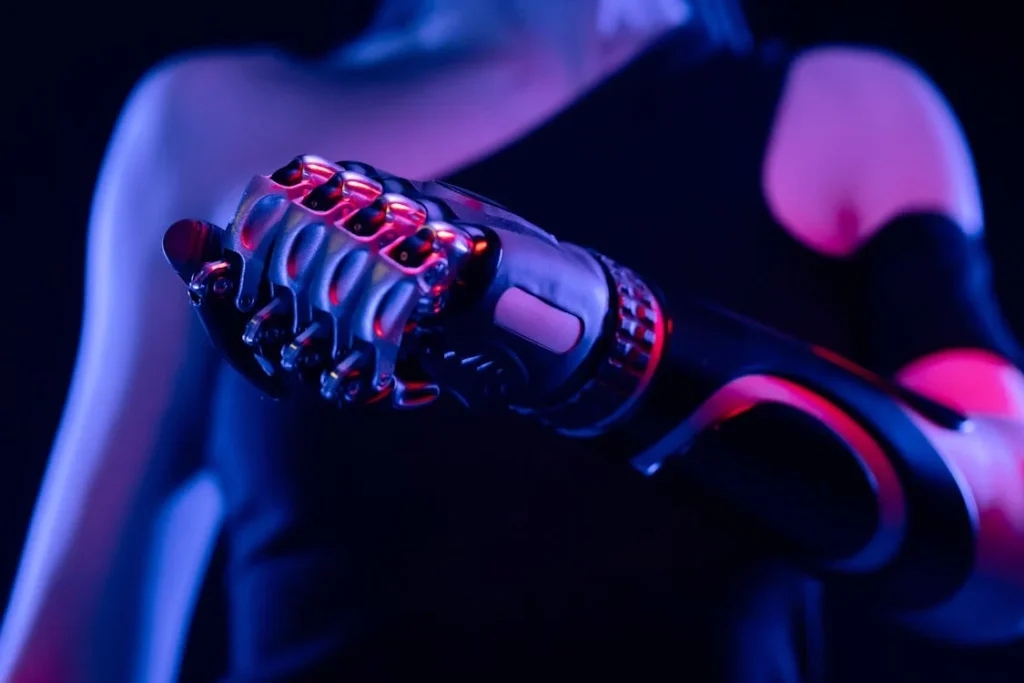
Muscle Memory Through Motion Mapping: How Games Guide Natural Movements
Teaching the Brain New Shortcuts
When someone learns to use a prosthetic, their brain is essentially creating new shortcuts. These aren’t the same routes it used before amputation. The brain has to find new paths to move the limb, balance the body, and respond to everyday tasks. And because these movements aren’t yet automatic, they often feel slow, clunky, and awkward.
Muscle memory happens when the brain finds the most efficient path for a movement—and then repeats it so many times that it becomes automatic. But for that to happen, the path needs to be clear. The motion must be clean, repeatable, and well-guided.
This is where gamified rehab plays a massive role. Through carefully designed digital environments and motion tracking tools, games can guide prosthetic users toward the correct patterns. Instead of just saying “try again,” these systems adjust the challenge in real time to teach the brain what the correct movement feels like.
At Robobionics, we’ve seen users make faster improvements when they train inside gamified systems that offer motion mapping. These platforms show visual guides—arrows, targets, or shadows of the correct motion—so the brain can better understand what “right” looks like. With every repetition, the brain maps that motion more clearly. And as the feedback becomes more precise, the movement becomes more natural.
This type of visual training is especially useful for upper-limb prosthetic users. Controlling finger grips, rotation, or subtle wrist movements takes practice. Without visual guidance, the brain often guesses its way through the motion. But with gamified overlays and real-time feedback, it learns with more accuracy. That leads to better muscle memory—and less frustration.
Patterns Over Power: Why Small Wins Matter
Muscle memory isn’t about strength. It’s about precision. The goal isn’t to make the biggest movement—it’s to make the right one, the same way, again and again, until the brain stores it like a shortcut.
Games help reinforce this by rewarding small wins. In traditional therapy, users might get one checkmark at the end of a session. But in gamified rehab, every successful repetition can offer its own sense of completion. The moment your prosthetic hand grabs the object correctly, you hear a sound. The moment your body aligns during balance practice, the screen lights up. That’s powerful.
Each small reward helps reinforce that specific movement. The brain doesn’t have to wonder, “Was that right?” It knows. That instant clarity reduces confusion. And when there’s less confusion, learning becomes faster.
We once worked with a young man training with a myoelectric prosthetic hand. He struggled with the closing motion—it either overshot or stopped too soon. We introduced a rhythm-based game where he had to close his hand in time with a beat. Within a week, his accuracy improved by 40%. Not because he trained harder—but because the pattern became clearer, faster, and easier to repeat.
That’s the power of small, repeatable success. It tells the brain, “Yes—this is the path. Do it again.”
Breaking Complex Tasks Into Levels
In a video game, you don’t start at the final boss. You start at level one. Each level teaches a new skill. One level might focus on timing. The next adds speed. Then precision. By the time you reach the tough parts, you’ve already built the foundation.
This is one of the most powerful aspects of gamified rehab. It breaks complex tasks—like using a bionic limb or walking with a new gait—into clear, digestible layers. You don’t try to do everything at once. You master one piece at a time.
For example, learning to reach and grasp with a prosthetic arm involves multiple steps: extend the arm, open the fingers, align with the object, close the grip, and return. That’s a lot to think about at once. But a well-designed game might focus only on the opening and closing motion first. Once that’s automatic, the next level might add reaching. Then object alignment. Then full integration.
Each level feels like progress. It adds to the last. And because it’s layered slowly, muscle memory builds more naturally. The brain absorbs each part without overload. And when it’s time to perform the full task, everything clicks together.
That’s the third key: games teach movement through progression. And progression is the foundation of strong, lasting muscle memory.
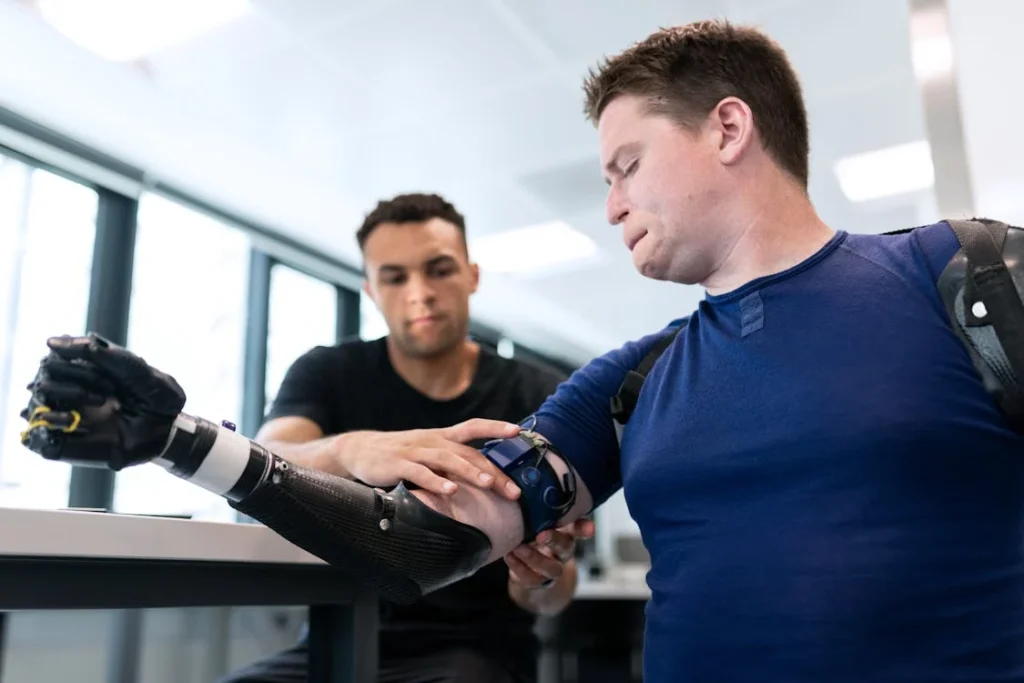
Emotion and Engagement: The Hidden Link Between Enjoyment and Muscle Learning
Why Emotion Helps Lock In Movement
People often talk about rehab as a physical process—lifting, stepping, stretching. But there’s another piece that’s just as important: emotion. Every time we feel something strongly, the brain remembers better. That’s true for words, for smells, for faces—and for movement.
When you connect emotion to a physical task, the brain pays closer attention. That’s because emotions signal importance. They tell the brain, “Store this. You might need it again.” This is why moments of joy, surprise, and even laughter can boost learning. And this is exactly where gamified rehab has an edge.
Games make rehab more enjoyable. They introduce excitement, curiosity, and a sense of play. And those feelings aren’t just a bonus—they’re part of what helps the brain remember.
We’ve seen patients who struggled through dull, repetitive drills suddenly come alive when a game is introduced. They smile, they get competitive, they focus. And under that focus, their bodies start to move more confidently. Their grip improves. Their balance steadies. They start trusting their prosthetic because the motions are tied to moments of real engagement.
That emotional boost isn’t artificial—it’s biological. When someone enjoys a task, they try harder. And when they try harder with a positive mindset, the learning runs deeper. That’s how emotion helps build muscle memory, one good feeling at a time.
The Role of Flow: When Learning Feels Effortless
There’s a mental state that game designers love to create. It’s called “flow.” You’ve probably felt it at some point—maybe while painting, solving a puzzle, or even dancing. It’s that moment where time disappears, distractions fade, and you’re completely focused.
Flow is one of the best states for learning. When you’re in flow, your brain becomes highly efficient. It tunes out the noise. It strengthens the signal. And in rehab, this means better, faster learning of movement.
Gamified rehab often creates flow without patients even realizing it. The challenge is just right—not too hard to cause frustration, not too easy to feel boring. There’s a clear goal. Immediate feedback. And a sense of progress.
When patients hit this sweet spot, they move more, concentrate better, and retain what they’ve learned. Their muscle movements become smoother. Their posture becomes more natural. And all of this happens with less mental resistance.
One of our patients, a woman learning to walk again with a below-knee prosthetic, told us she forgot she was even exercising during a game session. “It felt like I was just playing,” she said, “but then I noticed my balance was better. I wasn’t thinking so hard about where to place my foot anymore.”
That’s the goal: effort that doesn’t feel like effort. Practice that doesn’t feel like a chore. That’s when muscle memory really takes hold—when the body is busy learning and the mind is joyfully focused.
Confidence Fuels Repetition—and Repetition Fuels Memory
Let’s talk about confidence. It may seem like an emotional side-effect, but in rehab, confidence is a key driver of results. When someone believes they can do something, they’re more likely to try again. And the more they try, the better they get.
Gamified rehab builds confidence naturally. It celebrates small wins. It offers gentle correction without harsh judgment. And it helps users feel progress—even when it’s subtle.
This confidence is critical in prosthetic training. Many patients hesitate to use their new limb fully. They fear falling, failing, or doing it wrong. That hesitation slows progress. But when games frame each step as an achievement, patients begin to trust themselves more. They stop second-guessing. They stop pausing before each motion. And they begin to move with freedom.
That freedom is where real muscle memory starts to shine. When motion flows without mental blocks, the brain and body start to sync. The movements repeat with less effort. The patterns settle deeper. And the user begins to feel truly in control of their prosthetic.
This is why gamified rehab isn’t just about making therapy fun. It’s about making it emotionally safe. When the fear drops and the joy rises, discipline becomes easier—and muscle memory builds faster.
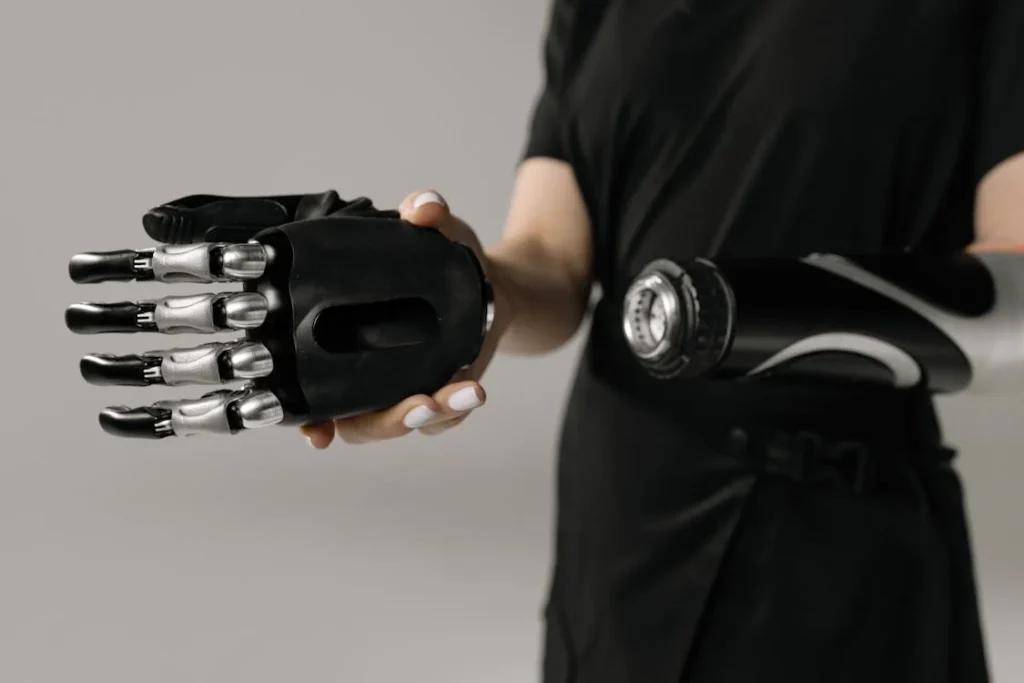
From Clinic to Daily Life: Translating Gamified Practice into Real-World Muscle Memory
Why Transfer Matters More Than Just Performance
It’s one thing to perform well inside a rehab center or during a gamified training session. It’s another to reach out and open a cupboard at home. Or walk unaided across a crowded room. The real test of muscle memory is whether it works outside the clinic—without coaching, without prompts, and without second-guessing.
This transfer from therapy space to real life is what truly marks progress for prosthetic users. And it’s one of the biggest challenges in any rehab journey. Movements that feel solid in a controlled environment can fall apart under pressure—at the market, in the rain, or during an emotional moment. That’s because real life is unpredictable, while rehab sessions are often too structured.
This is where gamified rehab gives users a powerful advantage. Games mimic unpredictability. They change pace. They introduce timed challenges. They simulate pressure—gently. So instead of just repeating the same task, users practice adapting. They learn how to respond. They develop faster reaction times and more flexible muscle control.
At Robobionics, we’ve seen that patients who engage with interactive, game-based tasks show better carryover into daily life. They don’t just learn to lift a virtual ball—they learn the rhythm and control needed to carry a plate or turn a doorknob. Because the muscle memory they build isn’t stiff—it’s smart.
Games Add Context, and Context Deepens Learning
Our brains don’t just memorize movements—they memorize situations. You don’t just remember how to walk—you remember how to walk through a hallway, with distractions, holding a bag. That’s contextual memory. And it’s vital for prosthetic users.
Gamified rehab creates space to practice in context. A game might ask the user to complete a task while managing balance. Or lift different-shaped objects that mimic everyday items. Or reach across their body in a way that reflects real dressing habits. These actions aren’t random. They mirror the small moments of daily life that make independence possible.
When muscle memory is built with context, it lasts longer. It holds up better under stress. And most importantly, it works when it’s needed the most.
We once worked with a teen learning to use a below-elbow prosthetic. Her training game included a virtual kitchen where she had to “cook” by grabbing, stirring, and pouring. After a few weeks, her family noticed something remarkable—she was starting to help out in the real kitchen, naturally, without prompts. Her body had learned what to do, and her brain had accepted it as normal. That’s transfer. That’s real muscle memory.
Real-World Confidence Starts with Playful Practice
Many prosthetic users hesitate to test their skills in public. They worry about falling. About fumbling. About being watched. That fear can hold them back—even when their body is ready. But confidence doesn’t just come from strength. It comes from familiarity. And gamified rehab builds that through repeated, low-pressure exposure.
By practicing under simulated conditions, users begin to trust their prosthetic. They get used to new sensations, timing, and limits. And because the setting feels fun—not clinical—they’re more relaxed. That relaxed state helps learning stick.
We’ve had users tell us that gamified training helped them “forget” they were doing therapy. That’s the highest compliment we can get. Because once the task stops feeling like effort, it starts becoming automatic. That’s when a movement turns into a reflex—and a prosthetic begins to feel like part of the body, not just a tool.
That internal shift is everything.
When someone uses their prosthetic hand to zip up a jacket without thinking, or steps down a curb without bracing, that’s success. And it often starts with moments inside a game—where safety, repetition, and creativity come together to build a real-life win.
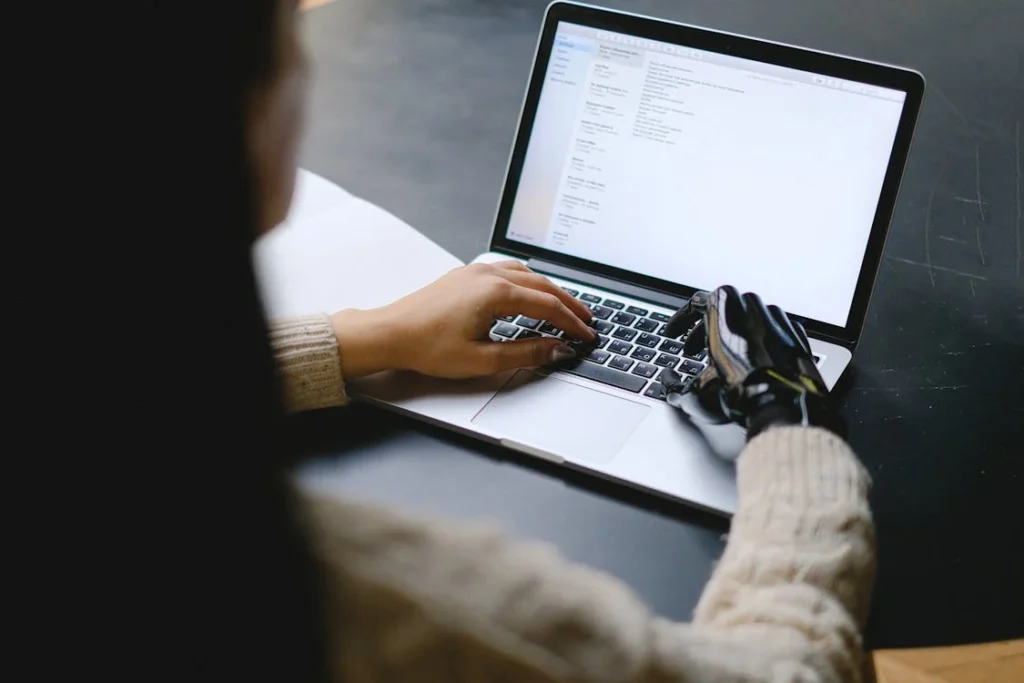
Customisation in Gamified Rehab: How Personalised Play Strengthens Muscle Memory
Why One-Size-Fits-All Doesn’t Work for Neuroplasticity
Every person’s recovery journey is different. One patient may struggle with grip strength. Another may have perfect strength but poor timing. One may be highly motivated by visuals; another might prefer sound or rhythm. The way a body relearns movement depends on the person, the prosthetic, and the brain’s unique response.
That’s why muscle memory isn’t just about repeating a task. It’s about repeating the right task for you—in a way your brain naturally responds to. This is where personalised gamification makes a huge difference.
Traditional rehab routines often involve standard sets of exercises. While they’re clinically effective, they may not always suit how each individual learns. Some find them too slow. Others find them too fast. And without that perfect zone of challenge, muscle memory doesn’t stick.
With gamified rehab, however, experiences can be tailored.
The game can speed up or slow down. It can adjust the level of challenge in real time. It can give extra support on weaker sides, or focus more on certain angles of motion. And as the patient improves, it grows with them. This adaptability keeps the brain engaged, and the learning sharp. The result? Faster, more lasting motor learning—without overloading or under-stimulating the user.
How Personalized Goals Shape Practice and Memory
Muscle memory grows stronger when it’s linked to a goal that matters to you. And the beauty of gamified rehab is that goals can be personalised to match what each user actually wants to achieve in life—not just what looks good on a report.
We worked with a man in his 60s whose biggest wish was to learn to write again with a prosthetic hand. Standard therapy focused mostly on picking up large objects. But with a customised gamified setup, we helped him train fine motor control using drawing games and letter-tracing puzzles. The game gave real-time visual feedback and gently increased difficulty over time. It didn’t just improve his motor function—it reignited his joy for practice. After a few weeks, he wrote a birthday card for his granddaughter, entirely on his own.
The emotion attached to that goal made the practice more meaningful. And meaningful repetition is what deepens memory.
This is why we always ask our patients: What do you want to do with your prosthetic? Not just walk or lift weights—but live, play, cook, write, hold hands. When the practice supports a real desire, the brain treats it with more urgency. It pays closer attention. It stores the patterns more deeply.
Personal Identity and the Psychology of Play
Muscle memory is tied not just to repetition but to belief. If a person doesn’t believe they are capable of mastering a movement, they’re less likely to stick with it. They may go through the motions—but the brain resists storing it as normal. It sees the motion as foreign. Temporary.
Gamified rehab can shift that belief.
By allowing users to personalise their experience—to choose avatars, themes, sounds, even game names—it invites them to bring their identity into their practice. It gives them a sense of ownership, control, and dignity. Instead of feeling like a patient, they feel like a player, a participant, a person with agency.
This shift matters more than we realise.
We’ve seen young users flourish when their game lets them pick superhero skins. We’ve seen elderly users light up when the game background shows a village similar to their own. These elements aren’t cosmetic. They shape emotional connection. And emotional connection enhances focus, motivation, and memory.
When users feel like this game is for me, they invest more. They concentrate more. And as a result, they learn faster. Their movements become cleaner, smoother, and more natural. That’s muscle memory shaped by identity, not just routine.
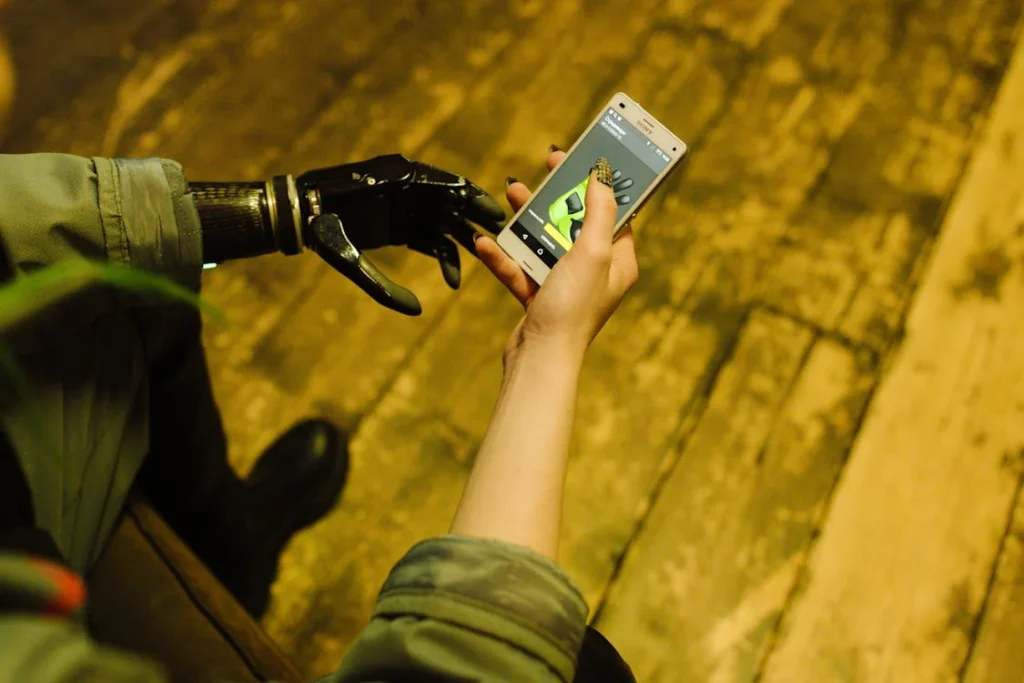
The Future of Gamified Rehab: AI, Sensors, and Smarter Muscle Training
How Technology Is Getting Better at Understanding Movement
Just a few years ago, rehab games were simple. Tap here. Move there. Basic motion detection, usually on a screen. But today’s technology is pushing gamified rehab into a new era—one that’s more responsive, more personalised, and far more powerful when it comes to building muscle memory for prosthetic users.
At Robobionics, we’re excited about how rapidly these tools are evolving. Motion sensors have become smaller, smarter, and more accurate. They no longer just track movement—they understand it. This means they can distinguish between shaky motion and smooth control, between hesitancy and precision. And when rehab software knows exactly how a user is moving, it can adjust on the fly.
That real-time adjustment is a game-changer for muscle memory. It keeps the challenge level exactly where it should be—not too easy, not too hard. And when the difficulty is perfectly tuned, the brain enters that ideal learning zone. That’s where muscle patterns are reinforced. That’s where memory gets built.
Smart sensors also give deeper feedback. They track angles, speed, tension, and posture. They can tell if you’re leaning too much on one side or moving your prosthetic out of alignment. Instead of needing a therapist to point this out, the system gives immediate feedback—through a light, a sound, or a prompt. The result? More accurate movements, less guesswork, and faster learning.
AI-Powered Rehab: Custom Paths for Every User
Artificial Intelligence is now making gamified rehab even more personal. In traditional therapy, a human therapist would adjust routines week by week. But AI systems can track progress daily—and adjust tasks in real time based on performance.
If you improve in one area, the challenge increases. If you struggle, the system dials it back or gives you a gentler route. This type of dynamic rehab means the patient is always working at their “sweet spot”—right where the most effective learning happens.
We’ve tested early AI-powered systems with our prosthetic training programs. One patient, recovering from an above-elbow amputation, was using an EMG-controlled prosthetic. His fine control was improving, but his rotation lagged behind. The AI game gradually began prioritising rotation-based challenges without him even noticing. He kept playing. And within two weeks, his rotation response caught up.
This kind of behind-the-scenes adaptation saves time and reduces frustration. It’s like having a digital coach who’s always watching, always learning, and always adjusting to make sure your movements get stronger—not just more frequent.
Biofeedback and the Missing Link Between Feeling and Form
Another exciting area is biofeedback. Many prosthetic users struggle with proprioception—the ability to “feel” where the limb is in space. This makes it hard to judge movement without looking or overcorrecting. But new gamified tools are beginning to bridge that gap using external sensors, haptic devices, and pressure pads.
These tools feed information back to the user in real time. Not through the prosthetic itself, but through signals elsewhere—maybe a vibration in the socket, a sound in the game, or a visual pulse on the screen. With enough practice, the brain begins to interpret these signals as “feeling.” It’s not the same as natural sensation—but it gives the user a new way to read their movement.
And this kind of biofeedback—combined with repetition and game-based tasks—helps build faster, more reliable muscle memory. The body begins to rely on this new data. Movements become smoother. Corrections become quicker. And the user feels more in control, because they finally have something to feel.
This is especially important for children and elderly users, who often need more intuitive systems to stay engaged. Gamified biofeedback can make difficult tasks feel like playful challenges—and still train the brain in a clinically meaningful way.
The Power of Progress That Never Sleeps
With these new technologies—AI, sensors, biofeedback—gamified rehab isn’t just becoming smarter. It’s becoming continuous.
Users can now train at home, at any time. The game remembers where they left off. It tracks their history, adapts their next steps, and logs everything for their therapist to review later. That means rehab is no longer limited to one session a day or a weekly visit to the clinic.
Muscle memory doesn’t wait. It builds whenever the right conditions are met. With gamified tools that are always ready and always learning, those conditions can be created at any time. Morning or night. Rain or shine. Motivation high or low.
And as the tech gets better, we expect this to become the norm. A world where prosthetic users aren’t just recovering—they’re evolving. Not with strain, but with smarter systems that reward effort, personalise progress, and help the brain and body connect faster, deeper, and with lasting impact.
Conclusion
Muscle memory is what gives us freedom—the freedom to move, to act, to live without overthinking every step. For prosthetic users, rebuilding that freedom takes time, patience, and smart repetition. But repetition alone isn’t enough. It needs to be engaging. It needs to make sense to the brain. And most of all, it needs to stick.
That’s where gamified rehab shines.
By turning ordinary therapy into purposeful play, it transforms effort into momentum. It keeps users focused, motivated, and emotionally connected to the process. It turns “I have to do this” into “I want to try again.” And when that shift happens, learning becomes faster, deeper, and more lasting.
At Robobionics, we’ve seen firsthand how games reshape rehab—not by replacing the science, but by enhancing it. They guide the body, support the brain, and remind users that every step forward—no matter how small—is worth celebrating.
Gamified rehab isn’t a gimmick. It’s a tool that brings joy to discipline, structure to growth, and most importantly, confidence to every motion. And when confidence fuels repetition, muscle memory takes care of the rest.
Recovery becomes smoother. Life becomes fuller. And the prosthetic becomes part of the person—not just in function, but in flow.


